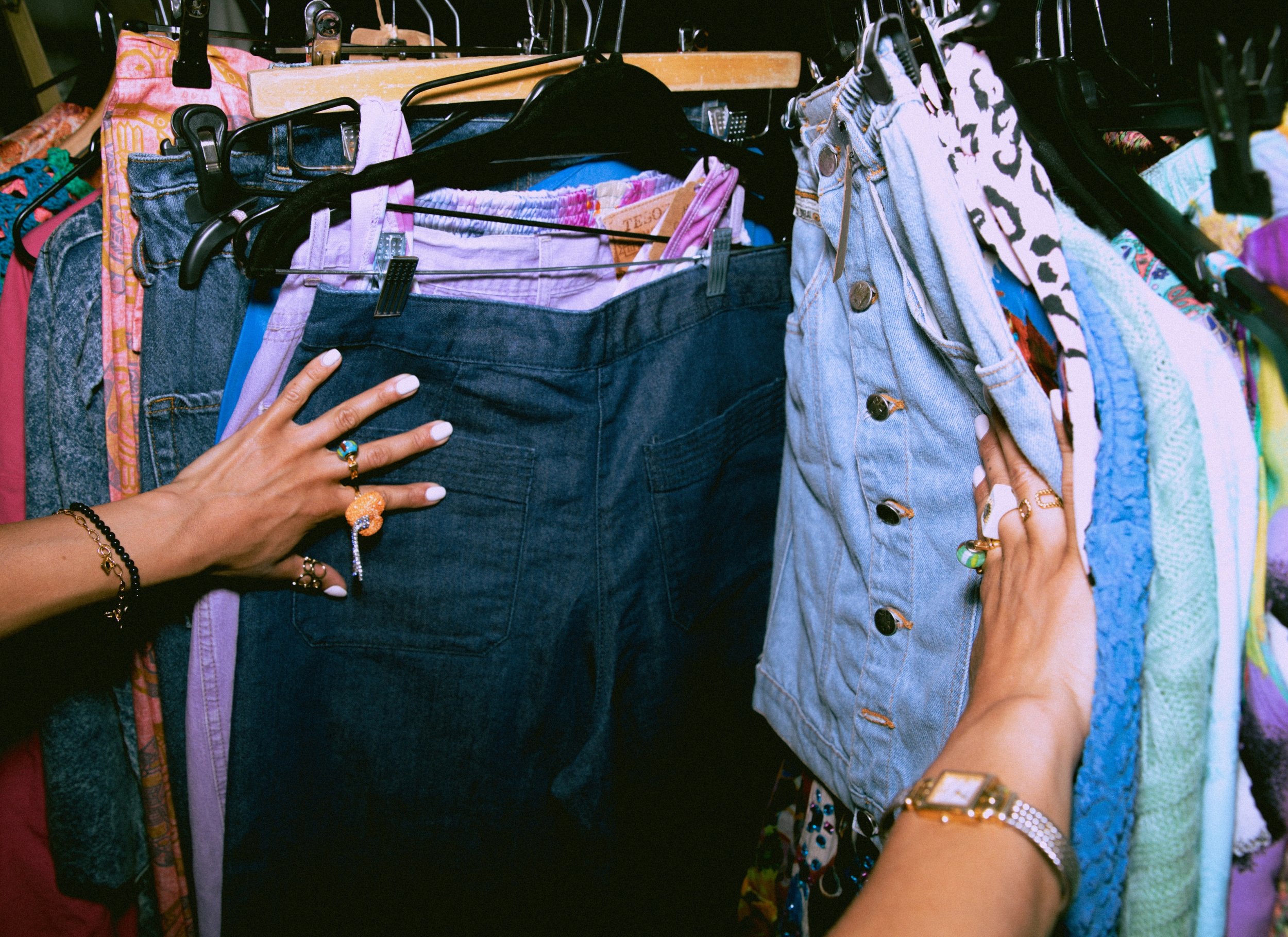HOW TO LIVE SUSTAINABLY ON A BUDGET
Nowadays, with the plethora of overpriced organic grocery stores and sustainable clothing companies, it can feel like you have to be a celebrity influencer or a business tycoon to even dream sustainably! Luckily, we’re here to tell you that there are plenty of different routes you can take on your journey to eco-living.
In this blog post, we’ll dive into some ways that the average Joe can protect the earth while also protecting their bank account. In fact, most of these sustainable living tips will actually end up saving you money – instead of just breaking even. From your new, mysterious subway-riding persona to epic thrift store finds that will make all your friends positively green with envy, you’ll certainly want to kiss your old habits goodbye in favor of a new, eco-friendly lifestyle.
Ready? Let’s get started.
How to Live Sustainably on a Budget
Thrifting Thrills
The popularity of thrift shopping has skyrocketed in the past couple of years, so chances are you may already be on the thrift store train. If not, allow us to convince you with a couple insider thrifting tips.
Instead of begrudgingly coughing up $70 plus tax for a basic button up and a couple pairs of socks, why not snag multiple shopping bags full of pre-loved treasures for around the same price?
In the end, you would have saved those items from the landfill AND spared the environmental impact of producing the new items that you would have bought instead. This also allows for indecisive dressers to change up their look often with whole new wardrobes. You can cycle through clothes quickly and guilt-free by simply thrifting and re-donating.
Of course you may come across the occasional stain or the perfect item in the wrong size, but there’s plenty of great finds just waiting to be found in thrift shops..providing you know where to look.
Choose Your Location Carefully
You would think that second hand stores would consistently offer good deals, but unfortunately they follow the same location-based price trends as any other product. If you can get out of big, expensive cities to do some small(er) town thrifting, your wallet and your wardrobe will thank you.
Sniff Out High Value Items
Chain thrift stores usually price based on category over brand or quality. For example, if all jackets are around $15, snag that Nordstrom blazer instead of the SHEIN bomber hanging next to it.
Always check the labels when shopping at thrift stores. Even if something isn’t your size or style, if designer-label items slipped through undetected you could always resell them for a higher price!
Peruse All the Sections
Girls – don’t be afraid to venture into the men’s section for some cool, vintage Levi’s or a comfy sweater.
Don’t skip out on the furniture and items sections either. You wouldn't want to end up kicking yourself for spending $150 on a press board TV stand from Target when there’s a $20 quality crafted antique version at your local thrift store. Same goes for kitchenware, art, books, games, decor, etc.
Thrift shopping is not only eco and budget friendly, but it can also be a great opportunity for a social outing. Go solo, grab a couple of besties, or make it a fun date with your SO.
DIY Diva
After hitting the thrift shops, why not personalize some of your finds? Embracing the do-it-yourself ethos is not only a budget-saver, but it's also a fantastic way to reduce waste and customize your belongings to your heart's content. Here are some DIY & upcycling projects that'll have you feeling like a sustainability superstar:
Home Goods... More Like Home Greats!
Turn trash into treasure with repurposing projects. Transform old crates into stylish shelves, pallet boards into a bed frame, or repurpose wine corks into a functional dart board. These projects not only save you money, but also keep these items out of landfills. Even if you fail, hopefully you had some fun and gained a new story.
Resurrect Old Threads
Have a pair of jeans that have seen better days? Give them a second chance with a bit of creative flair. Add some patches, distress them, or turn them into shorts. Going green has never been more fashionable.
DIY Santa
Show your loved ones you care with homemade gifts. Whether it's a hand-painted mug, a batch of homemade cookies, or a potted plant repurposed in a meaningful container, these gifts have a personal touch that store-bought items just can't match.
Customized Repairs
Got a favorite pair of sneakers with a worn-out sole? Instead of tossing them, learn basic shoe repair. A little glue and some new soles can extend the life of your footwear, saving you money and reducing waste. Now that you're a novice cobbler, why not keep it rolling and learn another handy trade? YouTube is practically begging to teach you how to reupholster that old couch.
Remember, repurposing and upcycling are all about seeing potential where others might not. With a little imagination, even the most unassuming or unwanted items can become something extraordinary. This is why thrifting and DIY go so great together! Start small, enjoy the process, and revel in the satisfaction of creating something unique and eco-friendly.
Tactical Transit
Public Transportation
Navigating public transit can seem daunting at first, but once you get started it’s really quite simple. Buses, trams, and trains are an excellent alternative to individual vehicles.
Skip the fuel, maintenance costs, parking fees, and hassle. The best part? You’ll massively cut down on carbon emissions. So sit back, relax, read a book, or scroll through your phone and arrive at your destination in eco-friendly style.
Pedal to the Pavement
Biking isn't just for leisure; it's a budget-friendly and eco-conscious way to get around town. Once you've invested in a reliable bike, the cost is minimal compared to the expenses associated with owning a car. Plus, it's a stellar workout conveniently built into your daily routine.
No fuel costs, no carbon emissions, and the added benefit of improving your health make biking a top choice for those looking to combine savings with sustainability. If you don’t want to own a bike or deal with parking and bike locks, check out your city's bike share options. Usually, for under a couple dollars per ride, these bikes are budget-friendly and sustainable to the core.
Carpooling
Pooling resources with colleagues or friends for your daily commute is a smart move for both your wallet and the environment. By sharing the expenses of fuel and parking, you'll notice a significant drop in your transportation costs. What's more, fewer cars on the road mean reduced traffic congestion and lower carbon emissions.
You’ll also get to look forward to some early morning chats each day (or drinking coffee in silence with a buddy, if that’s more your speed).
Eco-Cars
If personal transportation is a must, opting for a fuel-efficient or hybrid vehicle is a savvy choice. While the initial investment might be slightly higher, the long-term savings on fuel is substantial. These vehicles consume less petrol or gas, making them budget-friendly in the long run. Moreover, their reduced emissions contribute to a cleaner atmosphere.
Kitchen Caboodle
Buying in Bulk
Buying in bulk means less packaging waste, which is not only great for the environment but also kinder to your wallet. Grabbing essentials like rice, grains, and nuts in larger quantities often comes with discounted prices. Plus, it means fewer trips to the store, saving you both time and money in the long run.
Sayonara Single-Use Shopping
Picture this: a shopping trip where you leave with zero waste. That's the magic of package-free stores.
Bring your own reusable containers and bags, and stock up on everything from grains and legumes to oils and household items. By eliminating packaging costs, you're cutting down on your grocery bill while living sustainably. You'll also reduce food waste by getting the exact amount you need. It's a win-win scenario for both your pocket and the planet.
Urban Farming
Even if you're short on space, a bit of home gardening can work wonders for your budget and the environment. A small herb garden on your windowsill or a few potted plants can yield fresh, organic produce at minimal cost. Imagine plucking your own basil or cherry tomatoes for that homemade pasta sauce! Not only does it trim your grocery expenses, but it also gives you a hands-on connection with your food, making mealtime all the more rewarding.
These three strategies combine budget-friendly living with eco-conscious choices, proving that every trip to the kitchen can be a small step towards a greener, more budget-friendly lifestyle.
Embracing Minimalism
Lastly on our guide to living sustainably on a budget – consider a shift in perspective. Adopt different ways of consuming in your daily life and transition at your own pace towards a more minimalist way of living.
This can be extreme or subtle – it’s up to you. Luckily, embracing minimalism doesn't mean you have to give up essentials or things that bring you joy. It means simply becoming conscious of the unnecessary items that you purchase or keep in your space. As much fun as it may be to take something home from a shopping trip, if you’re unsure about it or feel the quality may be lacking, then skip it!
Instead, focus on essentials and extra items that currently and will continue to bring you joy. Then, phase out cheap, mass produced products that are bound to deteriorate. Turn to thrifting and the occasional splurge on a necessary, well-made item. Check out reusable products that can do the job of many single-use items. Not only will this declutter your space and mind, save you loads of cash and headaches about junk, but also it’s the most earth friendly way to consume.
On the other hand, if you’re the heir to a small fortune or a Kardashain lost on the internet, then go ahead and grab that $6 can of ethically sourced, local and vegan garbanzo beans. Why not drop $550 on a parka jacket hand stitched using only trash from garbage island? If you can and wish to splurge on ethically sourced items – we say go for it!
However, if you’re like most of us and are conscious of the money in your wallet, then get out there and start conveniently reducing your carbon footprint while also saving money.

















